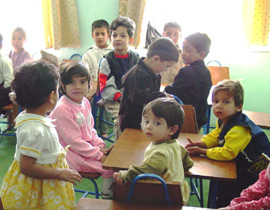Having taught English as a second language (TESL) for 6 years in China, I know how hard it is to teach English to young students. Especially those under 7 years old. Trying to keep their attention for 30 to 60 minutes, especially when teaching a class of 20 or so can seem impossible at times, but it is possible to teach them successfully, all you have to do is know some tricks.

Learning English Through Games
When teaching English to young children, you have to realize they don’t want to sit down and listen and repeat. They’ll do it, and having them repeating and writing things down is essential, but it needs to be broken up with various games and physical activities.
With these games you will have to keep them simple. Most young English learners will only know the most basic English words, and maybe 3 to 4 word sentences, if the game is complicated, they’ll be totally lost.
So you need to keep things fairly simple. Have a race to see who can grab an item you call out, Simon Says, I Spy, and so on. These use simple descriptions, words and actions that most children can follow. Having about 5 to 10 minutes of practicing words, followed by 5 minutes of these games will ensure that the words and phrases stick with the students. More importantly it keeps them from becoming bored and restless.
Keeping Students Attention
Another way to keep students focused on learning English, is to do a lot of physical interaction.
When you teach ‘under,’ ‘on top,’ ‘beside,’ etc, taking a chair and putting it on a student and “he is under the chair,’ always gets a laugh and demonstrates the meaning. For bigger laughs you can pretend to sit on the child. If there is a large box or cupboard in the room, putting the child inside, and closing it, is also a great way to teach inside.
This type of physical interaction goes right along with learning by playing.
If you are strong enough and very sure of yourself you could even pick one of the students up and show different actions like sideways, upside down, right side up, and so on, by flipping the child around. Just make sure to pick a braver student, it’s not good to scare the students too badly.
If you’re not that physically fit, tickling students, throwing soft balls around, and waving their arms, hair and other body parts are all seen as acceptable in most of Asia and South America.
Getting Students Involved
Whatever you do while teaching, getting students involved by asking easy questions, playing games where all the students participate, is essential. If a child is too shy to answer or play, let them sit it out, but make sure to talk with them during the class in a nice tone of voice for at least a minute, if the class is small you can make this longer. Most students by the 2nd or 3rd class will start responding.
If you teach a small class no more than 5 students, and there is a small break, you can turn the tables of the students. During the break have them teach you Chinese.
Children love to teach the teacher, and the more mistakes you make, the happier they will be. This will make them trust and like you more, which makes teaching them during the class easier. It also shows them that there is nothing wrong with making mistakes, a very uncommon way of thinking in most of Asia. Just be careful to only do this before class starts, after it ends or during a break. You’re there to teach English not learn Chinese.
These are basic tips that will help you get started teaching English to young children. Remember each class is different and you’ll have to learn about each one as you get experience with them. If you try a one size fits all strategy you will end up in trouble.
Featured images:
- License: Creative Commons image source
Dan Clarke has been teaching English in China to people of all ages for the last 6 years, however, recently he has begun to change his career as a travel writer with a focus on China. To learn about China you can visit his website, Living and Working in China.

